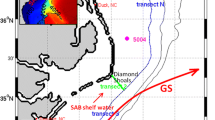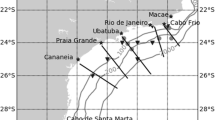Abstract
Cross-shelf transport is important due to its role in the transport of nutrients, larvae, sediments, and pollutants. The role of coastal trapped waves (CTWs) and their contribution to the cross-shelf transport is presently unknown. The impact of wind-driven CTWs on the structure of the cross-shelf currents and transport is investigated in the East China Sea (ECS) starting from theory. The cross-shelf currents are divided into four terms: the geostrophic balance (GB) term, the second-order wave (SOW) term, the bottom friction (BF) term and Ekman (EK) term, as well as three modes: the Kelvin wave (KW) mode, the first shelf wave (SW1) mode and the second shelf wave (SW2) mode. Comparison among these decompositions shows that (1) for the four terms, the effect of the GB and EK terms is continual, while that of the BF term is confined to 60–240 km offshore, and the contribution of the SOW term can be ignored; (2) for the three modes, the KW and SW1 modes are dominant in cross-shelf transport. The results show that the total cross-shelf transport travels onshore under idealized wind stress on the order of 10-1, and it increases along the cross-shelf direction and peaks about -0.73 Sv at the continental shelf margin. With the increase of linear bottom friction coefficient, the cross-shelf transport declines with distance with the slope becoming more uniform.
Similar content being viewed by others
References
Brink K H. 1991. Coastal-trapped waves and wind-driven currents over the continental shelf. Annual Review of Fluid Mechanics, 23 (1): 389–412.
Chapman D C. 1987. Application of wind-forced, long, coastal-trapped wave theory along the California coast. Journal of Geophysical Research: Oceans, 92 (C2): 1 798–1 816.
Chen D K, Su J L. 1987. Continental shelf waves along the coasts of China. Acta Oceanologica Sinica, 6 (3): 317–334. (in Chinese)
Clarke A J, Brink K H. 1985. The response of stratified, frictional flow of shelf and slope waters to fluctuating large-scale, low-frequency wind forcing. Journal of Physical Oceanography, 15 (4): 439–453.
Clarke A J, Van Gorder S. 1986. A method for estimating winddriven frictional, time-dependent, stratified shelf and slope water flow. Journal of Physical Oceanography, 16 (6): 1 013–1 028.
Colas F, Capet X, Mcwilliams J C et al. 2008. 1997–199. El Niño offPeru: a numerical study. Progress in Oceanography, 79 (2–4): 138–155.
Dong L X, Guan W B, Chen Q et al. 2011. Sediment transport in the Yellow Sea and East China Sea. Estuarine, Coastal and Shelf Science, 93 (3): 248–258.
Echevin V, Albert A, Lévy M et al. 2014. Intraseasonal variability of nearshore productivity in the Northern Humboldt Current System: the role of coastal trapped waves. Continental Shelf Research, 73: 14–30.
Fewings M, Lentz S J, Fredericks J. 2011. Observations of cross-shelf flow driven by cross-shelf winds on the inner continental shelf. Journal of Physical Oceanography, 38 (11): 2 358–2 378.
Gill A E, Clarke A J. 1974. Wind-induced upwelling, coastal currents and sea-level changes. Deep Sea Research and Oceanographic Abstracts, 21 (5): 325–345.
Gill A E, Schumann E H. 1974. The generation of long shelf waves by the wind. Journal of Physical Oceanography, 4 (1): 83–90.
Hamon B V. 1962. The spectrums of mean sea level at Sydney, Coff’s Harbour, and Lord Howe Island. Journal of Geophysical Research, 67 (13): 5 147–5 155.
Hsueh Y, Pang I C. 1989. Coastally trapped long waves in the Yellow Sea. Journal of Physical Oceanography, 19 (5): 612–625.
Huthnance J M. 1995. Circulation, exchange and water masses at the ocean margin: the role of physical processes at the shelf edge. Progress in Oceanography, 35 (4): 353–431.
Li J Y, Zheng Q A, Hu J Y et al. 2015. Wavelet analysis of coastal-trapped waves along the China coast generated by winter storms in 2008. Acta Oceanologica Sinica, 34 (11): 22–31.
Liu K K, Tang T Y, Gong G C et al. 2000. Cross-shelf and along-shelf nutrient fluxes derived from flow fields and chemical hydrography observed in the southern East China Sea offnorthern Taiwan. Continental Shelf Research, 20 (4–5): 493–523.
Mitchum G T, Clarke A J. 1986. The frictional Nearshore response to forcing by synoptic scale winds. Journal of Physical Oceanography, 16 (5): 934–946.
Tilburg C E. 2003. Across-shelf transport on a continental shelf: do across-shelf winds matter? Jo urnal of Physical Oceanography, 33 (12): 2 675–2 688.
Wang J, Yuan L Y, Pan Z D. 1988. Numerical studies and analysis about continental shelf waves. Acta Oceanologica Sinica, 10 (6): 666–677. (in Chinese)
Weber J E H, Drivdal M. 2012. Radiation stress and mean drift in continental shelf waves. Continental Shelf Research, 35: 108–116.
Xie F, Pang Y, Zhuang W et al. 2008. Study on regularity of matter transportation in the Nearshore Area of the Haizhou Bay. Advances in Marine Science, 26 (3): 347–353. (in Chinese)
Yin L P, Qiao F L, Zheng Q A. 2014. Coastal-trapped waves in the East China Sea observed by a mooring array in winter 2006. Journal of Physical Oceanography, 44 (2): 576–590.
Yuan D L, Hsueh Y. 2010. Dynamics of the cross-shelf circulation in the Yellow and East China Seas in winter. Deep Sea Research Part II: Topical Studies in Oceanography, 57 (19-20): 1 745–1 761.
Zhang S, Alford M H, Mickett J B. 2015. Characteristics, generation and mass transport of nonlinear internal waves on the Washington continental shelf. Journal of Geophysical Research: Oceans, 120 (2): 741–758.
Acknowledgement
The authors would like to thank Prof. Liang, Prof. Weber, Prof. Wang and Kenny for their kindly help in this work.
Author information
Authors and Affiliations
Corresponding author
Additional information
Supported by the National Natural Science Foundation of China (Nos. 41476022, 41506044), the Program for Innovation Research and Entrepreneurship Team in Jiangsu Province, the National Program on Global Change and Air-Sea Interaction (No. GASI-IPOVAI-05), and the Startup Foundation for Introducing Talent of Nanjing University of Information Science and Technology (Nos. 2013r121, 2014r072)
Rights and permissions
About this article
Cite this article
Jiang, L., Dong, C. & Yin, L. Cross-shelf transport induced by coastal trapped waves along the coast of East China Sea. J. Ocean. Limnol. 36, 630–640 (2018). https://doi.org/10.1007/s00343-018-7008-x
Received:
Accepted:
Published:
Issue Date:
DOI: https://doi.org/10.1007/s00343-018-7008-x




